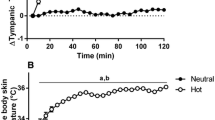Abstract
The study was conducted to investigate the thermoregulation of young children compared to that of adults. A group of 19 children (ages 9 months-4.5 years), with only 3 children aged 3 years or above, and 16 adults first rested in a thermoneutral room (air temperature 25°C relative humidity 50%, air velocity 0.2 m·s−1). They were then exposed to a hot room (air temperature 35°C, relative humidity 70%, air velocity 0.3 m·s−) next door for 30 min, and then returned to the thermoneutral room where they stayed for a further 30 min. The rectal temperature (T re), skin temperatures (T sk) at seven sites, heart rate (HR), total sweat rate (\((\dot M_{sw,t} )\)), local sweat rate (\((\dot M_{sw,1} )\)) and the Na+ concentration of the sweat were measured. There was no significant difference inT re between the children and their mothers in the rest phase. However, theT re of the children increased as soon as they entered the hot room and was significantly higher than during the control period, and than that of the mothers during heat exposure. MeanT sk, forehead, abdomen and instepT sk were significantly higher in the children during both the thermoneutral and heat exposure. The\((\dot M_{sw,t} )\) was significantly higher and Na+ concentrations in the sweat on the back and upperarm were significantly lower for the children during the heat exposure. They had a greater body surface area-to-mass ratio than the mothers by 64%, which indicated that they had advantages for thermal regulation. However, the sweating andT sk responses of the children were not enough to prevent a rise in body temperature. These results would suggest that the young children had the disadvantage of heating up easily due to their smaller body sizes and there may be maturation-related differences in thermoregulation during the heat exposure between young children and mothers.
Similar content being viewed by others
References
Araki T, Toda T, Matsusita K, Tsujino A (1970) Age differences in sweating during muscular exercise. J Phys Fitness Jpn 28:239–248
Bar-or O (1980) Climate and the exercising child -a review. Int J Sports Med 1:53–65
Danks DM, Webb DW, Allen J (1962) Heat illness in infants and young children. BMJ 2:287–293
Drinkwater BL, Kupprat IC, Denton JE, Crist JL, Horvath SM (1977) Response of prepubertal girls and college women to work in the heat. J Appl Phyiol 43:1046–1053
Foster KG, Hey EN, Katz G (1969) The response of the sweat glands of the newborn baby to thermal stimuli and to intradermal acetylcholine. J Physiol 203:13–29
Fujimoto K, Watanabe T, Sakamoto A, Yukawa K, Morimoto K (1967) Studies on the physical area of Japanese, 18. Calculation formulas in three stages over all age (in Japanese). Jpn J Hyg 21:443–450
Hardy JD, DuBois EF (1937) The technic of measuring radiation and convection. J Nutr 15:461–474
Haymes EM, Buskirk ER, Hodgson JL, Lundegren HM, Nicholas WC (1974) Heat tolerance of exercising lean and heavy prepubertal girls. J Appl Physiol 36:566–571
Hey EN, Katz G (1969) Evaporative water loss in the new-born baby. J Physiol 200:605–619
Kawahata A (1960) Sex differences in sweating. In: Yoshimura H, Ogata K, Itoh S (eds) Essential problems in climatic physiology. Nankodo, Kyoto, pp 169–184
Kosuge T (1939) Ability to perspire in childhood (in Japanese). J Physiol Soc Jpn 4:370–377
Kuno Y (1956) Human perspiration. Thomas, Springfield, Ill.
Okayasu K (1950) Studies on the regulation of human body temperature from a standpoint of age (in Japanese). Bull Inst Constit Med 1:166–169
Shiraishi T, Araki T (1990) Comparative study on thermoregulation under heat exposure between children and adults-with special reference to sweating and skin temperature reactions (in Japanese). Jpn J School Healeh 32:134–143
Tanaka M (1956) Studies on important biological factors influencing the ability to perspire, 1. Effect of age on ability to perspire (in Japanese). J Physiol Soc Jpn 18:390–394
Tochihara Y, Ohnaka T, Watanabe Y (1995) Thermal responses of 6-to 8-year-old children during immersion of their legs in a hot water bath. Appl Human Sci 14:23–28
Wagner JA, Robinson S, Tzankoff SP, Marino RP (1972) Heat tolerance and acclimatization to work in the heat in relation to age. J Appl Physiol 33:616–622
Webster MED (1987) Temperature regulation in children. In: Shiraki K, Yousef MK (eds) Man in stressful environments. Thermal and work physiology. Thomas, Springfield, Ill., pp 35–43
Author information
Authors and Affiliations
Rights and permissions
About this article
Cite this article
Tsuzuki-Hayakawa, K., Tochihara, Y. & Ohnaka, T. Thermoregulation during heat exposure of young children compared to their mothers. Eur J Appl Physiol 72, 12–17 (1995). https://doi.org/10.1007/BF00964108
Accepted:
Issue Date:
DOI: https://doi.org/10.1007/BF00964108




